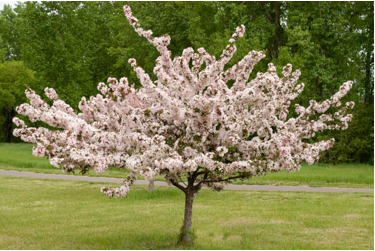Trees come in a wide variety of shapes and sizes, but it’s important to recognize which tree sizes are appropriate for your space. Below you’ll find a simple classification of the different tree sizes as well as some well-known examples for you to consider when selecting the right tree for your property.
What is a Small Tree?
Small trees are no more than 15 feet tall. A common misconception about small trees is that they need hardly any space to grow, but even a small tree needs at least 6 feet between itself and a wall or another tree for it to flourish.
Some popular small trees include:
- Crabapple – beautiful flowering trees that also bear small reddish-orange fruit, perfect for encouraging wildlife activity
- Flowering Dogwood – comes in a variety of different colors, sheds its leaves in winter but grows gorgeous flowers in the springtime
- Serviceberry – multiple different types that bear sweet, edible fruit and beautiful flowers when properly maintained
- Eastern Redbud – low maintenance with pink-red flowers and heart-shaped foliage
What is a Medium Tree?
Medium trees are typically in the 15 – 40 feet height range. These trees should be planted roughly 30 feet apart for optimum growth. While this might sound excessive, it’s still important to give trees in this height range plenty of space to branch out under the soil. Medium-sized trees are also known as ‘shade trees’, as they are the most common height range for your average yard tree.
Some popular medium trees include:
- Oak – available in several varieties including a few evergreens that are majestic all year round, tend to stay around the medium size but can grow much larger
- American Hornbeam – low maintenance, unique shape, leaves change to a beautiful dark red in fall before dropping off for the winter
- Maple – size, and color varies, but the most recognizable is the red maple with its brilliant red leaves (although this variant can grow into a large tree)
- Elm – fast-growing, dark and dense foliage, the perfect shade tree
What is a Large Tree?
Large trees are 40 feet and above in height. These trees prefer to be at least 40 feet from other trees or buildings where possible. Because of this, they generally aren’t recommended for your average backyard and are generally kept for large open areas such as parks.
Some popular large trees include:
- Bald Cypress – highly adaptable, bright green leaves and layered foliage, doesn’t spread very wide instead tapering to a soft point towards the top
- Pine – several variants but generally featuring the thin, tall stature and needle-like foliage all year round
- Sycamore – a sturdy giant with beautiful, delicate-looking foliage
- American Sweetgum – easily recognizable with its pinkish foliage, prefers a slightly warmer climate
Which Tree is Right for My Property?
You need to ensure that you have an appropriate amount of space on your property before planting any trees at all. If too many trees are planting too close together, it will stunt their growth and some of the trees may never reach maturity. Trees especially need plenty of space between each other to prevent the roots of one tree from choking another tree by stealing its nutrients. However, if a tree is planted too close to the side of a building, it can be trimmed to prevent it from becoming a hazard.
Properly mapping out your backyard or another area where you intend on planting some trees is a must. Once you know the area you’re working with, selecting the proper tree size should be a piece of cake. Keep in mind not to overcrowd your area with a massive tree that might not suit the space as well as something smaller and simpler. No matter the size, a properly maintained tree can completely transform an area for the better.
Now that you know the best tree size, what are the best tree species for your Maryland lawn? Find out in my next post!
Need tree trimming services in Davidsonville? Our arborists can help!
